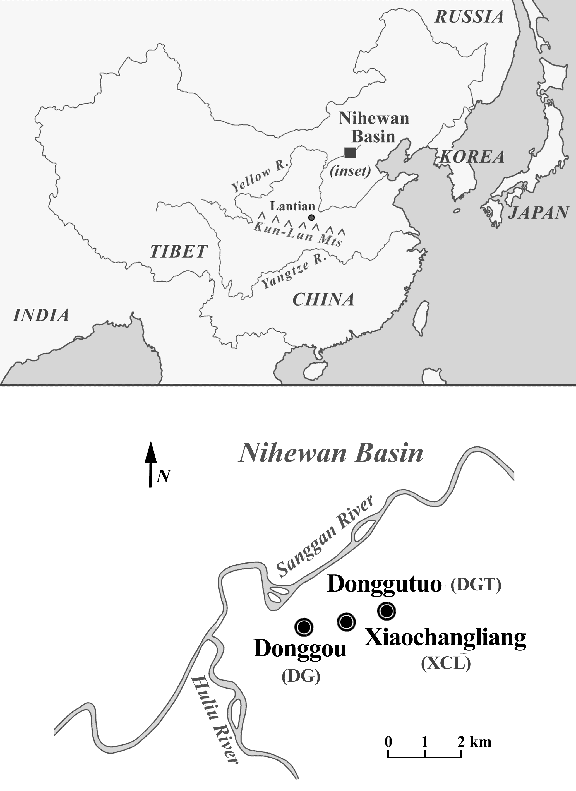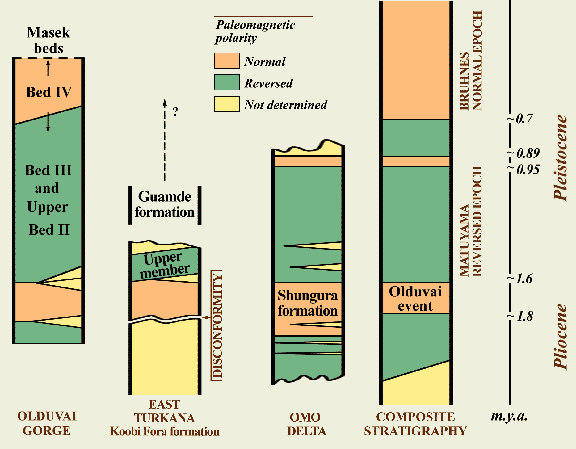|
Understanding the chrononology of early migrations to Asia by hominids (beginning
with Homo erectus) as well as their subsequent activities has continuously
been hampered by lack of suitable dating methods. Such early archaeological
materials are far too old for radiocarbon dating (limited to organics up
to about 60,000 years old) and require geological dating methods. Much of
the Asian region, however, particularly at cave sites, lacks the volcanic
deposits usable (as in East Africa) for potassium/argon or argon/argon dating,
which can reach back to date strata formed millions of years (myr) before
present. (myr) before
present.
Every so often,
however, researchers can find a way out of such predicaments by using other
techniques. Simple flaked stone tools, discovered over 20 years ago in the
ancient lake sediments of Xiaochangliang in China’s Nihewan Basin (fig.1),
were recently redated by paleomagnetism to 1.36 myr by geologist Rixiang
X. Zhu of the Chinese Academy of Science in Beijing. Although not the oldest
clues of hominids in Asia (Java in Indonesia and Dmanisi, Georgia date to
1.7- 1.9 myr; AR 1,1; 2,4), they add to the very few early
and securely dated materials on the continent and they also contribute a
new piece to the Asian puzzle - evidence for higher latitude living.
Fig.1: China's Nihewan Basin (after Zhu et al. 2001).
The method of high resolution, paleomagnetic dating used by Zhu and his team
to determine the tools’ age relies on known shifts in the Earth’s
magnetic field, which get recorded in sediments that contain iron particles.
By analyzing the direction in which iron grains are aligned in a specific
layer of sediment, one can know where magnetic north was at the time the
material was deposited. Geologists have recorded such ancient changes in
the magnetic field in places where they can also directly radiometrically
date the sediments - such as at East African sites of Olduvai Gorge, Tanzania
and Lake Turkana, Kenya - to produce the known dates of such global events
(fig.2). This allows researchers to tie archaeological remains to a specific
time period even in places where direct dating is not possible.
Zhu’s team scaled the Nihewan Basin’s steep slopes, taking sediment
samples at 25-35 centimeter intervals in a verticle line, intersecting the
horizontal layers of sediment which lie above, in, and below the one in which
the stone tools were found. After analyzing the position of the grains in
this series of samples, the whole Nihewan (Chinese) sequence was compared
to and matched up with the known magnetic shifts in a Plio-Pleistocene section
from East Africa. As it turned out, the Nihewan artifact level lay in a
reversed-polarity layer (deposited at a time when magnetic north had shifted
to the South Pole). It fell in between a
 normal-polarity
period (where magnetic north was actually near the North Pole) dated
radiometrically at Olduvai Gorge to 1.77 to 1.95 million years ago, and one
dated there to one million years ago (fig.2). From the position of the Nihewan
artifact layer within this band of reversed-polarity sediment, using estimated
sedimentation rates, Zhu and his colleagues, including geophysicist Ken Hoffman
of California Polytechnic State University, conclude that the tools should
date from at least 1.36 myr. normal-polarity
period (where magnetic north was actually near the North Pole) dated
radiometrically at Olduvai Gorge to 1.77 to 1.95 million years ago, and one
dated there to one million years ago (fig.2). From the position of the Nihewan
artifact layer within this band of reversed-polarity sediment, using estimated
sedimentation rates, Zhu and his colleagues, including geophysicist Ken Hoffman
of California Polytechnic State University, conclude that the tools should
date from at least 1.36 myr. Fig.2: East African stratigraphies in Olduvai Gorge, East Turkana, and
the Omo Delta, with paleomagnetic phases.
Project colleague and anthropologist Richard Potts (Smithsonian
Institution) surmises that the climate may have been milder than the harsh
temperatures known today in the region, but nevertheless, migrating here
would have been a challenge. The hominids who made the tools, presumably
Homo erectus, had to traverse the Tibetan Plateau and navigate the
Himalayas to reach this site which lies between the North China Plain and
the Inner Mongolian Plateau at 40 degrees north latitude, 150 kilometers
west of Beijing. Furthermore, the formidable Qinling (Kunlun) Mountains prevented
southern migrations from this area.
This research facilitates new perspectives about the early human migrations
to Asia. It provides the oldest unambiguous evidence for hominids in East
Asia at 40 degrees north latitude, suggesting that Homo erectus was
able to adapt to a broad range of habitats. It also clearly shows, according
to archaeologist Kathy Schick (Indiana University) among others, that early
on in the Homo lineage, our ancestors had the ability to spread from Africa
into other continents over vast and perhaps arduous terrain with relatively
simple tools.
References:
Bower, B. 2001. Science News 160 (29 Sept. 2001).
Gibbons, A. 2001.
Science 293 (28 Sept. 2001).
Zhu, R.X., Hoffman, K., Potts,
R., Deng, C., Pan, Y., Guo, B., Shi, C., Guo, Z., Yuan, B., Hou, Y., Huang,
W. 2001. Nature 413 (27 Sept. 2001).
This article appears in the Recent Finds in Archaeology section of Vol.3, No.2 of Athena
Review.
.
|
|